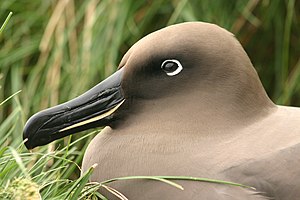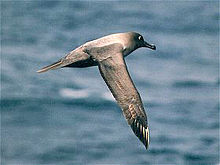Black albatross
| Black albatross | ||||||||||
|---|---|---|---|---|---|---|---|---|---|---|

Black Albatross ( Phoebetria palpebrata ) |
||||||||||
| Systematics | ||||||||||
|
||||||||||
| Scientific name | ||||||||||
| Phoebetria palpebrata | ||||||||||
| ( Forster , 1785) |
The black albatross ( Phoebetria palpebrata ) is a bird in the albatross family . The IUCN classifies the species as potentially endangered because of its long-declining populations. Losses from longline fisheries contributed to the decline .
Appearance
The black albatross reaches a body length of 79 to 89 centimeters and a wingspan of 183 to 218 centimeters. While the back and underside are colored ash gray, the plumage on the head is dark grayish-brown and a white ring surrounds the eye. The grayish-brown wings have blacker hand wings and the long tail is black. The bill, also black, has a pale blue line.
Fledglings are similar to adult birds, but their plumage is more brown and the eye ring is less noticeable.
Distribution area
The black albatross is widespread in the southern oceans between 55 ° and 35 ° S. It breeds on islands like South Georgia , Bouvet , Macquarie , Kerguelen , Heard, and Campbell . Occasional black albatrosses also reach the northern hemisphere. For example, on July 17, 1994, a black albatross was observed in the Cordell Bank National Marine Sanctuary off the coast of northern California. On the open sea, they are quite common in the Drake Passage .
Reproduction
Black albatrosses usually breed in loose colonies or small groups, but occasionally there are also single breeding pairs. The nest is built on the edge of an overgrown cliff or on a steep slope and is built to protect it from the prevailing westerly winds. The nest is about 15 to 30 centimeters high and 45 to 55 centimeters in diameter.
A single egg is laid in October or November and is not replaced when lost. Both parent birds are alternately involved in the brood. The time that a single parent bird spends on the nest varies from one to two days to almost a month. After hatching in December or January, which extends over a period of three to five days, the parent birds hover the nestling alternately for the first 20 days. The nestling is then left alone in the nest while the parents look for food. They return to the young bird every one to three days.
The entire nestling time from hatching to fledgling lasts 140 to 170 days. Most young birds leave their nest in May or June. Black albatrosses form long-standing pair bonds that can last for several decades. The pair bond is renewed by a complicated courtship at the breeding site. Black albatrosses usually brood for the first time when they are eight to 15 years old. They usually brood every two years, but on average a nestling only grows every five years. Black albatrosses are able to breed up to an age of at least 32 years, and in the wild they reach an age of about 40 years.
| Breeding island | Breeding pairs | trend |
|---|---|---|
| Possession Island | 996 | −13% over a period of 15 years |
| Remaining Crozet Islands | 1.404 | Unknown |
| South Georgia | 5,000 to 7,500 | Unknown |
| Kerguelen | 3,000 to 5,000 | Unknown |
| Auckland Islands | 5,000 | Unknown |
| Macquarie Island | 2,000 | Unknown |
| Campbell Island | 1,600 | Unknown |
| Antipodes Island | 170 | Unknown |
| Heard Island | 200 to 500 | Unknown |
| Marion Island | 179 | Stable |
| Prince Edward Island | 150 | Unknown |
| King George Island | 5 | Unknown |
| total | 58,000 | -20% to -29% over a period of 100 years |
Others
The black albatross , the wandering albatross and the dark albatross are considered to be the albatross species with the most graceful flight ability.
literature
- Jonathan Alderfer (Ed.): Complete Birds of North America. National Geographic, Washington DC 2006, ISBN 0-7922-4175-4 .
- James McQuilken, Rolf Stange (ed.): The mists of time. Spitzbergen.de-Verlag, 2012, ISBN 978-3-937903-15-6 .
Web links
- Videos, photos and sound recordings on Phoebetria palpebrata in the Internet Bird Collection
- Phoebetria palpebrata onthe IUCN Red List of Threatened Species .
Single receipts
- ↑ a b c d e f Phoebetria palpebrata in the IUCN Red List of Threatened Species . For sale by: BirdLife International. Retrieved May 17, 2015.
- ↑ a b c Jonathan Alderfer (Ed.): Complete Birds of North America. National Geographic, Washington DC 2006, ISBN 0-7922-4175-4 , p. 68.
- ↑ Christian Walther: ANTARCTICA . 10th edition. Conrad-Stein-Verlag, May 2018, p. 255 .
- ^ Colin Harrison, C. Harrison, A. Greensmith: Birds of the World . Ed .: E. Bunting. Dorling Kindersley, New York, NY 1993, ISBN 1-56458-295-7 , pp. 49 .
- ↑ a b c d C. JR Robertson: Albatrosses (Diomedeidae). In: Michael Hutchins, Jerome A. Jackson, Walter J. Bock, Donna Olendorf: Grzimek's Animal Life Encyclopedia - Birds I Tinamous and Ratites to Hoatzins. 2nd Edition. Gale Group, Farmington Hills, MI 2003, ISBN 0-7876-5784-0 , pp. 119-120.
- ↑ B. Kerkove, A. Lindsay: Phoebetria palpebrata. Animal Diversity Web, 2008, accessed May 17, 2015 .
- ↑ James McQuilken: The Mists of Time . Ed .: Rolf Stange. 1st edition. Spitzbergen.de, 2012, ISBN 978-3-937903-15-6 , pp. 137 .
